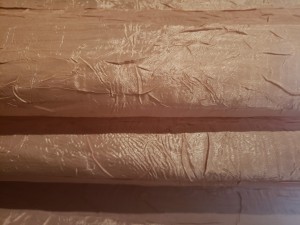 Can I dye gold polyester sheers white?
Can I dye gold polyester sheers white?
Add your voice! Click below to answer. ThriftyFun is powered by your wisdom!
I have doubts that this will be successful as very often item will never be a true white as polyester is difficult to work with.
Also, the seams may be cotton blend and may turn out to remain a darker shade.
Also, the original 'color' of the curtain material may not have been true white before it was dyed as some curtain material may be a 'natural' color (could have been light beige) and that could prevent it from turning out snow white.
I think, if you try this, you should be prepared to maybe dye your curtains another color just in case they are not true white.
Also, if these are not new curtains, the extra 'movement' that is required may weaken the fabric and cause tears.
There is no way to turn any colored fabric white without first removing the color, in your case gold.
Avoid using chlorine-based bleaches, such as sodium hypochlorite (which is the active ingredient in most household bleach). They cause permanent damage to polyester in the form of a dull yellowish stain that cannot be removed.
Not all dye colors can be removed. Some dyes are easy to remove, but others cannot be removed, no matter what you do. Unless you know exactly what dye was used on your material, the only way to find out whether it can be removed is to try it. Therefore, take a not big piece of your fabric and try removing the color.
How to remove dye from fabric:
Combine the dye-stripping product and the required amount of water (as designated on the packaging) in a stainless steel pot.
You can also try "White discharge disperse dye polyester".
For White Discharge the printing paste is prepared as follows:
200 parts Safolin, 70 parts Water, 650 parts Loust bean gum (10%) or Meyprogum (8%), 30 parts Citric acid or (1 - 2 parts Tartaric acid), 50 parts Thiodiethylene Glycol. 1000 parts textilechemrose.blogspot.com/
Your fabric should lose its gold color and turn white or at least light. If it doesn't turn completely white, then you need to turn it white.
Natural dyes work at the cellular level with natural fibers - natural is defined as originating from plant or animal sources. Polyester fibers are not made up of cells, but consist of long chains of molecules derived from petroleum as an industrial byproduct. Although liquid polyester can be colored during the fiber-formation process, modern chemical dyes have been developed to color finished polyester textiles. To dye polyester, you need chemical dyes that react with the synthetic fibers. The class of chemical dyes used for polyester fabrics is called dispersion dyes. You can dye polyester to any other color at home using dispersion dyes in a hot-water dye bath, but not white, as there is no white dispersion dyes.
There are several options for turning polyester to white (try them using the piece of your fabric):
1. Using an opaque pigment.
However, unlike dyes, pigments do not have any ability to stick to the surface. In order to make a pigment stick, you have to mix it with something that will act as a glue. Titanium dioxide is a good white pigment, but, like any pigment, without a binder to glue it on to the fabric, it will just fall off. If you mix it with an acrylic fabric medium, then it can stick; dry heat treatment may be necessary to make the effects of the acrylic binder permanent.
2. Using fabric paint.
The mixture of a pigment with a binder is called paint. You shouldn't use just any paint on fabric, because many of them dry to be stiff, hard, and scratchy. For painting fabric, you need to buy special fabric paint. Many fabric paints are just as transparent as dyes, so you have to look specifically for an opaque fabric paint. Some fabric paints will bind to natural fibers, but not to synthetic fibers such as polyester, so be careful to choose an opaque fabric paint whose manufacturer specifies that it will work on synthetic fibers. Jacquard Products makes a line of opaque fabric paints called Neopaque that is supposed to work on both natural and synthetic fibers.
Bleaching probably will ruin the fibers. If you can afford to experiment, maybe try Rit Color Remover on a different (disposable) all-polyester item first. (For example, Dollar store bandana's usually are polyester.) Good luck!
Here's a vid on how to use color remover:
www.youtube.com/
It would probably cost more money, time versus buying a new set. I could see white going to gold but gold to white I would not risk it personally.
Add your voice! Click below to answer. ThriftyFun is powered by your wisdom!